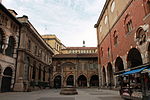Biblioteca europea di informazione e cultura
Italian digital librariesItaly stubsLibraries in MilanPhotographic collections and books
The Biblioteca Europea di Informazione e Cultura (BEIC, "European library of information and culture") is an ongoing project based in Milan, Italy for the realization of a new modern library. It began in the late 1990s, when Antonio Padoa-Schioppa submitted the idea for the first time to the City of Milan and the Italian Ministry of Cultural Heritage and Activities and Tourism. The library is split in two main units: physical and virtual.
Excerpt from the Wikipedia article Biblioteca europea di informazione e cultura (License: CC BY-SA 3.0, Authors).Biblioteca europea di informazione e cultura
Via Silvio Pellico, Milan Municipio 1
Geographical coordinates (GPS) Address Nearby Places Show on map
Geographical coordinates (GPS)
| Latitude | Longitude |
|---|---|
| N 45.4649 ° | E 9.1892 ° |
Address
Via Silvio Pellico 1
20121 Milan, Municipio 1
Lombardy, Italy
Open on Google Maps









